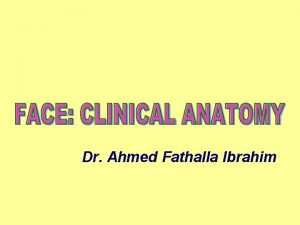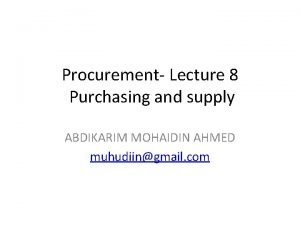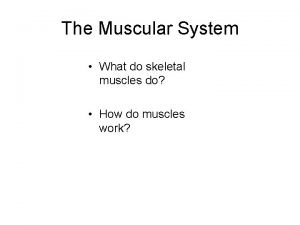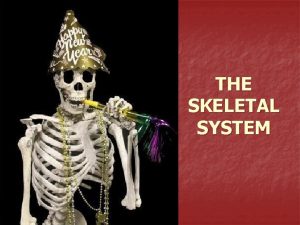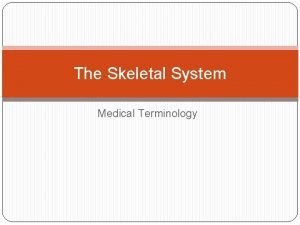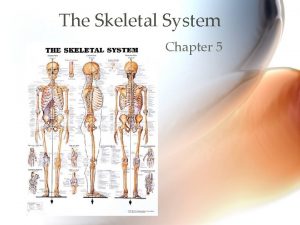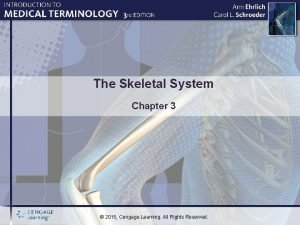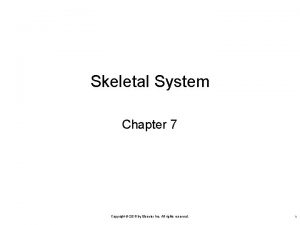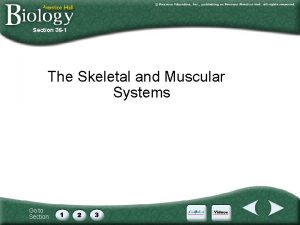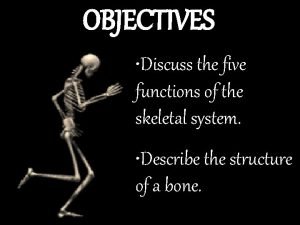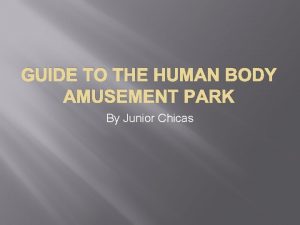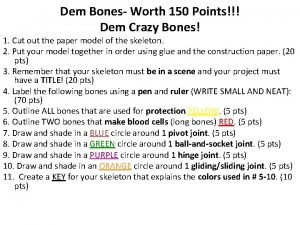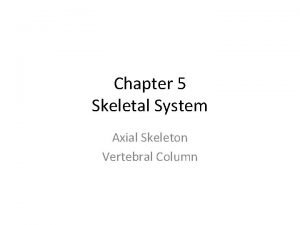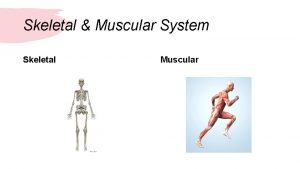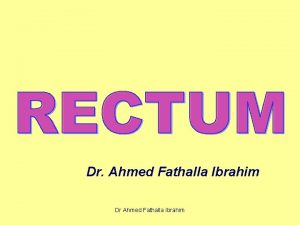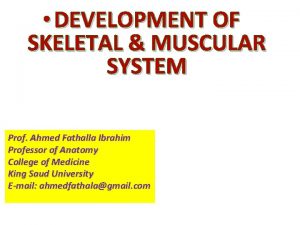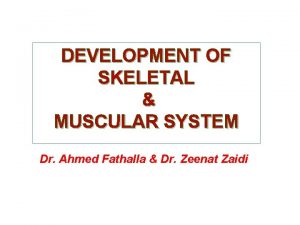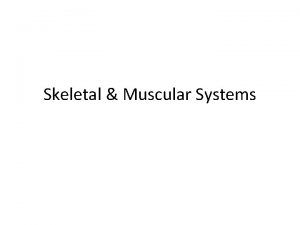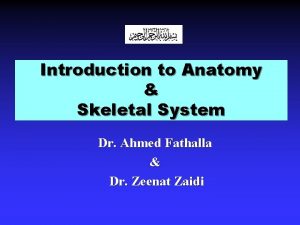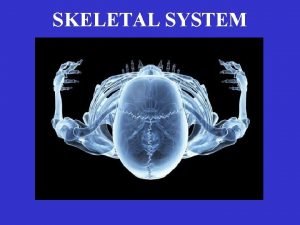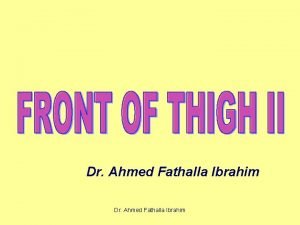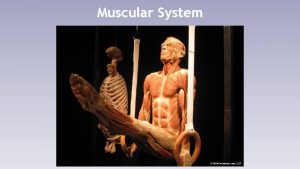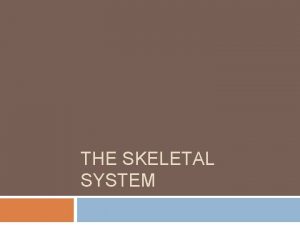DEVELOPMENT OF SKELETAL MUSCULAR SYSTEM Dr Ahmed Fathalla



















- Slides: 19

DEVELOPMENT OF SKELETAL & MUSCULAR SYSTEM Dr. Ahmed Fathalla Ibrahim Associate Professor of Anatomy College of Medicine King Saud University E-mail: ahmedfathala@hotmail. com Dr. Zeenat Zaidi Associate Professor of Anatomy College of Medicine King Saud University zeenatzaidi@hotmail. com

OBJECTIVES At the end of the lecture, the student should be able to describe the: • Division of the intraembryonic mesoderm. • Formation and division of somite. • Derivatives of somite (sclerotome & myotome). • Formation of somatic and splanchnic layers of lateral plate mesoderm and their derivatives. • Difference between the intramembranous and intracartilaginous ossification and name the bones developed by these processes. • The origin of skeletal, cardiac and smooth muscles in the body.

Intraembryonic Mesoderm q Develops between Ectoderm & Endoderm EXCEPT in the central axis of embryo where NOTOCHORD is found. q Differentiates into 3 parts: 1. Paraxial mesoderm: on each side of notochord. 2. Intermediate mesoderm 3. Lateral mesoderm Notochord: stimulates neural tube formation 3 2 1

q Paraxial mesoderm divides into units (somites). q Lateral mesoderm divides by intraembryonic coelom Somatic mesoderm into: q. Somatic mesoderm (between ectoderm & Intraembryonic celome coelom). q. Splanchnic mesoderm (between endoderm & coelom).

• A small cavity, the myocele appears in each somite but soon disappears • Each somite divides into ventromedial part called sclerotome and dorsolateral part the dermomyotome Sclerotome: Bones of the axial skeleton (cranium, vertebral column, ribs and sternum) Myotome: Associated muscles of the back & Dermatome: The adjacent dermis of the skin

Development of the Bones • Based on the mode of development, there are two types of bones in the body: • Cartilage bones, that develop via intracartilagenous (endochondral ossification). A cartilage model first forms and is eventually replaced with bone e. g. formation of the bones of the axial & appendicular skeletons and the cranial base. • Membrane bones, that develop via intramembranous ossification. Bone forms directly from mesenchymal cells without the prior formation of cartilage e. g. majority of bones of the face and skull

Development of Cranium (Skull) § The skull bones develops from mesoderm around the developing brain. § The skull consists of: 1. Neurocranium: protective case for brain Neuro 2. Viscerocranium: skeleton of face Viscero § Bones of skull ossify either by: • Intracartilagenous (Endochondral) ossification, or • Intramembranous ossification

Bones of skull that ossify by intramembranous ossification: 1. Frontal 2. Parietal 3. Zygomatic 4. Squamous temporal 5. Maxilla 6. Mandible Base of skull develops by intracartilagenous ossification 2 1 3 4 5 6 2 1

Mesenchyme from lateral mesoderm Induces growth of mesenchyme & its transformation into cartilage Cartilage ossifies by: Endochondral ossification Myoblasts migrate from myotomes to form: Muscles of limbs

Ossification of Long Bones Bone in cartilaginous state Appearance of primary ossification centers: ossification of diaphysis Appearance of secondary ossification centers: ossification of epiphysis Ossification of epiphseal plate: Complete union of epiphysis & diaphysis Epiphyseal plate of cartilage Diaphysis Growth of bone stops Diaphysis BIRTH Epiphysis PUBERTY Bone increases in length by proliferation of epiphyseal plate Bone age is a good index of general maturation. Bone age is determined by: 1. Appearance of ossification centers in diaphysis & epiphysis (specific for each bone & sex) 2. Disappearance of epiphyseal plate (specific for each bone & sex)

Development of Joints They develop from mesoderm lying between bones: bones q In fibrous joints: mesoderm differentiates into dense fibrous connective tissue q In cartilaginous joints: mesoderm differentiates into cartilage. q In synovial joints: a synovial cavity is formed inside mesoderm; mesoderm differentiates into synovial membrane, capsule & ligaments

Summary of Development of Bone All bones develop from MESODERM q AXIAL SKELETON: *Vertebrae, ribs & sternum: from sclerotomes of somites (paraxial mesoderm) *Skull: from mesoderm surrounding the brain q APPENDICULAR SKELETON: from somatic part of lateral mesoderm All bones ossify by endochondral ossification EXCEPT: EXCEPT 1. Some bones of skull 2. Clavicle

12 weeks embryo

DEVELOPMENT OF MUSCLES § All muscles develop from MESODERM EXCEPT muscles of iris (eyeball) and myoepithelial cells of mammary & sweat glands which develop from ECTODERM § Cardiac muscles develop from: splanchnic part of lateral mesoderm § Smooth muscles: § In the wall of viscera from: splanchnic part of lateral mesoderm § In the wall of blood & lymphatic vessels from: somatic part of lateral mesoderm § All skeletal muscles develop from myotomes of paraxial mesoderm EXCEPT some head & neck muscles which develop from mesoderm of pharyngeal arches

Myotome • Each myotome divides into: § Dorsal Epaxial division § Ventral Hypaxial division • The Epaxial division gives rise to the muscles of the back (extensor muscles of the vertebral column) • Ventral Hypaxial division gives rise to the muscles of the ventral body wall Myoblasts migrate into limb and give Limb muscles

QUESTION 1 q. Which one of the following group of muscles are derivatives from epaxial division of myotomes? 1. Muscles of back 2. Muscles of limbs 3. Muscles of viscera 4. Cardiac muscles

QUESTION 2 q Which one of the following bones ossifies by intramembranous ossification? 1. Vertebra 2. Humerus 3. Ribs 4. Mandible

QUESTION 3 q. Regarding the ossification of long bones, which one of the following statement is correct? 1. Primary ossification centre appears after birth. 2. Secondary ossification centre leads into ossification of diaphysis. 3. Long bones ossify by intramembranous ossification. 4. When epiphysis unites with diaphysis, growth of bone stops.

thank u & good luck
 Ahmed fathalla
Ahmed fathalla Ahmed muhudiin ahmed
Ahmed muhudiin ahmed Major skeletal muscles
Major skeletal muscles Skeletal and muscular system
Skeletal and muscular system Chapter 36 skeletal muscular and integumentary systems
Chapter 36 skeletal muscular and integumentary systems Chapter 14 skeletal muscular and nervous systems
Chapter 14 skeletal muscular and nervous systems Plyometrics disadvantages
Plyometrics disadvantages 5 main functions of the skeleton
5 main functions of the skeleton Medical terminology skeletal system
Medical terminology skeletal system Chapter 5 the skeletal system
Chapter 5 the skeletal system Chapter three skeletal system kaplan answer key
Chapter three skeletal system kaplan answer key Chapter 7 skeletal system
Chapter 7 skeletal system Chapter 5 the skeletal system figure 5-13
Chapter 5 the skeletal system figure 5-13 Section 36-1 the skeletal system
Section 36-1 the skeletal system Five functions of the skeletal system
Five functions of the skeletal system Your body is an amusement park
Your body is an amusement park Skeletal system dem crazy bones
Skeletal system dem crazy bones Chapter 6 the skeletal system answer key
Chapter 6 the skeletal system answer key 7 12 5 spine
7 12 5 spine Chapter 32 section 2 the skeletal system answer key
Chapter 32 section 2 the skeletal system answer key
